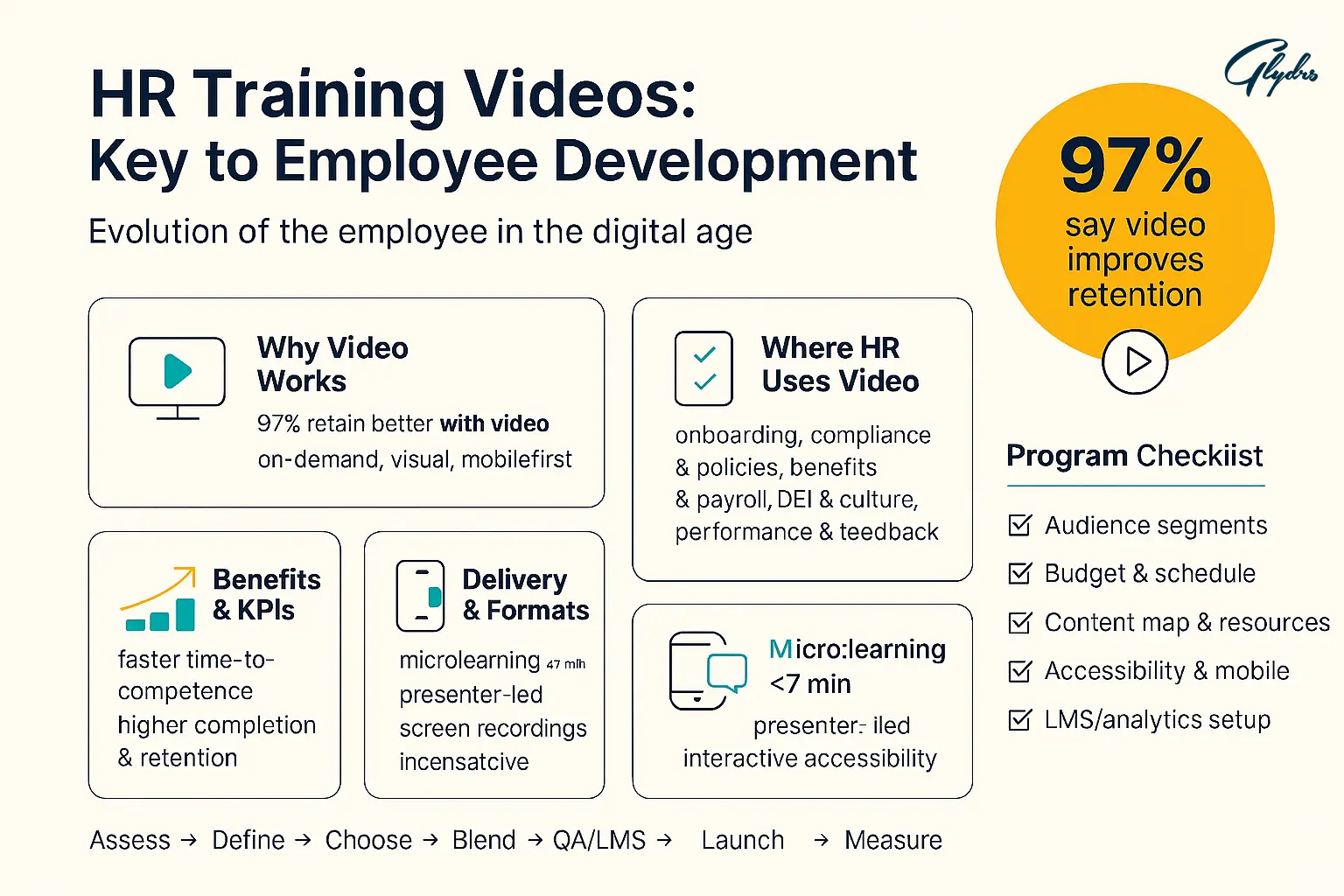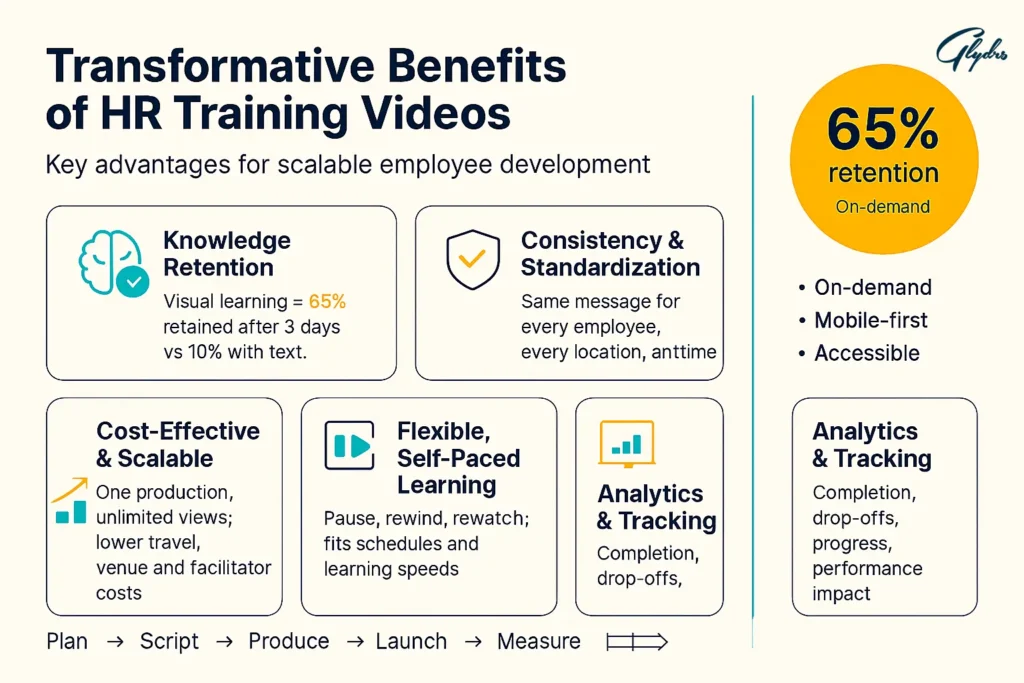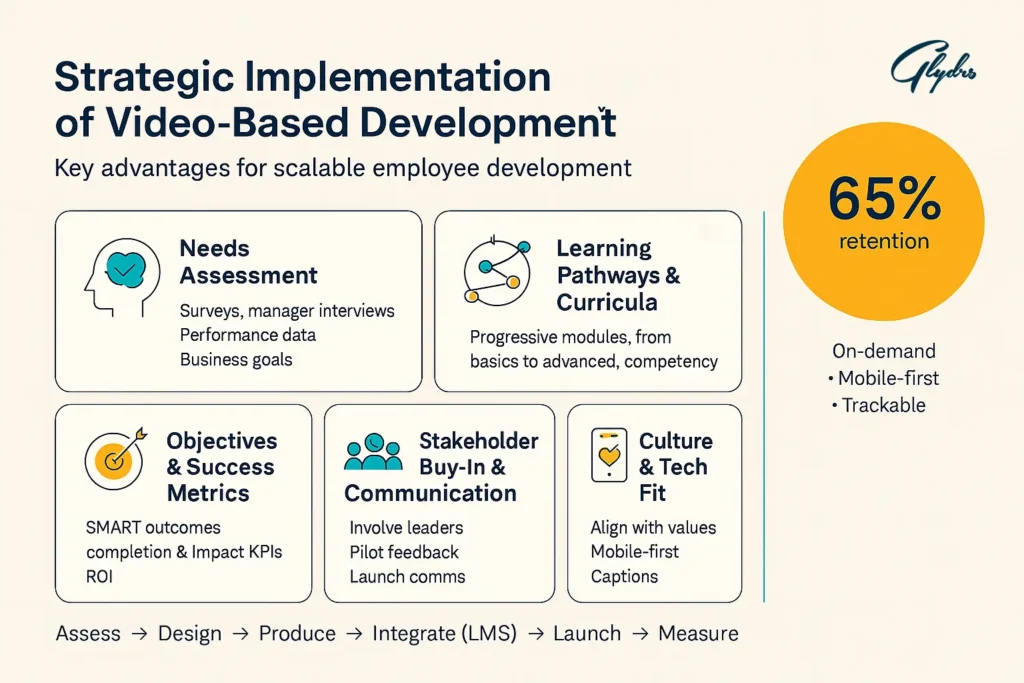
14 Oct How HR Training Videos Play a Key Role in Employee Development
HR Training Videos: Evolution of the Employee in the Digital Age
You’ve witnessed a dramatic transformation in how organizations approach employee development over the past decade. Traditional classroom-style training sessions, lengthy PowerPoint presentations, and thick employee handbooks are rapidly becoming relics of the past. In their place, you’re seeing a dynamic shift toward visual, interactive, and engaging learning experiences that speak directly to how your modern workforce prefers to consume information.
Consider this: when you implement HR Training Videos into your development strategy, you’re tapping into the same learning preferences that drive billions of hours of video consumption daily. Research from Synthesia reveals that 97% of professionals find video more effective for retaining information compared to traditional text-based methods. This isn’t just a preference—it’s a fundamental change in how your employees process and remember critical workplace knowledge.
Your workforce today demands training that fits their schedules, accommodates their learning styles, and delivers value without disrupting their productivity. You’re managing teams that span multiple generations, locations, and skill levels, each with unique expectations about how professional development should be delivered and experienced.
The Science Behind Video Learning and Employee Growth
When you choose video-based learning for your development programs, you’re leveraging decades of cognitive science research that demonstrates the superiority of visual learning. Your employees’ brains are naturally wired to process visual information more efficiently than text—processing visual content up to 60,000 times faster than written words.
You’ve probably noticed that your team members have different learning preferences. Some are visual learners who need to see concepts demonstrated, others are auditory learners who benefit from narrated explanations, and kinesthetic learners who require interactive elements. HR Training Videos uniquely address all three learning styles simultaneously, ensuring that your development initiatives reach every member of your team effectively.
The storytelling aspect of video content creates emotional connections that enhance memory retention. When you incorporate real workplace scenarios, employee testimonials, or leadership messages into your training videos, you’re creating narrative structures that help your employees contextualize and remember important information long after the training session ends.
Engagement rates tell the story clearly: Forrester Research found that employees are 75% more likely to watch a video than read documents, emails, or articles. This means your carefully crafted development content actually gets consumed rather than sitting unopened in email inboxes or gathering digital dust on company intranets.

Transformative Benefits of HR Training Videos for Employee Development
You’ll discover that implementing video-based development programs delivers measurable advantages that extend far beyond simple knowledge transfer. When you invest in HR Training Videos, you’re creating a foundation for sustained employee growth that scales with your organization’s needs and adapts to your workforce’s evolving requirements.
Knowledge retention improves dramatically when you deliver development content through video. Your employees retain 65% of visual information three days later, compared to only 10% of text-based information. This enhanced retention means your development investments actually stick, creating lasting behavioral changes and skill improvements that impact daily performance.
Your organization benefits from unprecedented consistency in development and delivery. When you create standardized video content, every employee receives identical information, eliminating the variables that come with different trainers, locations, or time constraints. Whether you’re onboarding new hires in your headquarters or developing remote team members across multiple time zones, everyone receives the same high-quality development experience.
Cost-effectiveness becomes apparent quickly when you analyze the economics of video-based development. While initial production requires investment, you can deliver the same content to unlimited employees without additional costs. Compare this to traditional training methods, where you pay for facilitators, venue rentals, travel expenses, and time away from productive work for every single session.
Your employees gain the flexibility to engage with development content on their own schedules. They can pause, rewind, and re-watch sections as needed, creating personalized learning experiences that accommodate different paces and comprehension levels. This self-directed approach increases completion rates and satisfaction with development programs.
Analytics and tracking capabilities provide you with unprecedented visibility into your development program effectiveness. You can monitor completion rates, identify where employees disengage, track progress through learning pathways, and measure the impact of specific content on performance outcomes.
Essential Types of HR Training Videos That Drive Employee Growth
Your development strategy should encompass various video formats, each designed to address specific aspects of employee growth and organizational needs. Understanding which types of HR Training Videos serve different purposes helps you create comprehensive learning experiences that support employees throughout their entire career journey with your organization.
Onboarding and orientation videos establish the foundation for new employee success. You can create welcoming experiences that introduce company culture, values, and expectations while reducing the anxiety that often accompanies starting a new position. These videos ensure consistent messaging about your organization’s mission and help new hires feel connected to their teams and objectives from day one.
Skill-building and technical competency videos address the ongoing need for professional development in rapidly evolving industries. You can demonstrate complex procedures, software applications, or technical processes with crystal clarity, allowing employees to learn at their own pace and reference materials as needed during real-world application.
Leadership development content prepares your high-potential employees for increased responsibilities and management roles. You can feature current leaders sharing insights, demonstrate effective management techniques, and provide guidance on handling difficult situations that emerging leaders will inevitably face.
Compliance and safety training videos ensure your organization meets regulatory requirements while protecting employees from workplace hazards. You can present potentially dry material in engaging formats that help employees understand not just what they must do, but why these requirements exist and how they benefit everyone in the organization.
Soft skills and communication enhancement videos address the interpersonal capabilities that often determine career success. You can demonstrate effective communication techniques, conflict resolution strategies, and emotional intelligence concepts that help your employees build stronger professional relationships and advance their careers.
Supporting Employees Through Different Development Stages
Your employees’ development needs change significantly as they progress through their careers, and your video-based learning programs should reflect these evolving requirements. By creating targeted content for different career stages, you ensure that your development investments remain relevant and valuable throughout each employee’s journey with your organization.
Entry-level employees require foundational knowledge about your industry, organization, and role-specific competencies. You can create a comprehensive video series that builds essential skills systematically, helping new professionals establish strong performance patterns and understand career advancement pathways within your organization.
Mid-career professionals need opportunities to deepen expertise and expand their skill sets. Your video content for this audience should focus on advanced techniques, strategic thinking, and specialized knowledge that help experienced employees stay current with industry trends and prepare for leadership opportunities.
Leadership pipeline development requires sophisticated content that addresses the unique challenges of managing people and driving organizational results. You can create videos that explore complex leadership scenarios, strategic decision-making processes, and the soft skills necessary for inspiring and motivating teams.
Continuous learning initiatives keep your entire workforce adaptable and engaged. You can develop ongoing video content that introduces new technologies, industry developments, and emerging best practices, ensuring your team remains competitive and innovative.
Performance improvement and remedial training address specific challenges without stigmatizing employees who need additional support. Video-based remedial training allows employees to address performance gaps privately while receiving consistent, patient instruction that helps them succeed.

Strategic Implementation of Video-Based Development Programs
Your success with HR Training Videos depends heavily on thoughtful planning and strategic implementation that aligns with your organization’s culture, technology infrastructure, and business objectives. Rushing into video production without proper preparation often results in content that fails to engage employees or deliver meaningful development outcomes.
Conducting thorough needs assessments helps you understand exactly what knowledge gaps exist within your organization and which development priorities will deliver the greatest impact. You should survey employees, interview managers, analyze performance data, and review business objectives to create a comprehensive picture of your development needs.
Creating learning pathways and curricula ensures that your video content builds logically and systematically toward defined competency goals. You can design progressive learning experiences that guide employees from basic concepts to advanced applications, creating clear roadmaps for professional development.
Integration with existing Learning Management Systems streamlines administration and tracking while ensuring employees can easily access development content. You should evaluate your current technology infrastructure and plan for seamless integration that doesn’t require employees to learn new systems or navigate complex access procedures.
Establishing clear learning objectives and success metrics allows you to measure the effectiveness of your video-based development programs and demonstrate return on investment. You can define specific, measurable outcomes that align with business goals and track progress toward these objectives over time.
Building internal buy-in requires communication strategies that help employees understand the value and relevance of your development programs. You should involve key stakeholders in content planning, gather feedback during development, and create excitement about learning opportunities that advance both individual careers and organizational success.
Measuring the Impact on Employee Development Outcomes
Your investment in video-based development programs requires systematic measurement to ensure you’re achieving desired outcomes and maximizing return on investment. Effective measurement goes beyond simple completion rates to examine actual behavior change, skill acquisition, and business impact that result from your development initiatives.
Key performance indicators should encompass both learning metrics and business outcomes. You can track completion rates, engagement levels, and assessment scores while also monitoring performance improvements, promotion rates, and employee satisfaction with development opportunities.
Skill acquisition and competency improvements require both objective assessments and subjective feedback. You should implement pre- and post-training evaluations that measure specific knowledge gains while also gathering manager and peer feedback about observable behavior changes and improved performance.
Employee engagement and satisfaction with video training provides crucial insights into program effectiveness and areas for improvement. You can conduct regular surveys to understand how employees perceive the quality, relevance. And value of your development content, using this feedback to refine and enhance future offerings.
Retention rates and career progression metrics demonstrate the long-term impact of your development investments. You should analyze whether employees who participate in video-based development programs show higher retention rates, faster advancement. And greater job satisfaction compared to those who don’t engage with these opportunities.
ROI calculation methods help you quantify the financial benefits of your development programs and justify continued investment. You can compare the costs of video production and delivery against savings from improved performance. Reduced turnover, faster onboarding, and decreased training overhead.
Keep reading and uncover secrets that can change the way you work. Online Course Video Production: Scripts, Storyboards & LMS
Overcoming Common Implementation Challenges
Your journey toward effective video-based employee development will inevitably encounter obstacles that require creative problem-solving and persistent effort to overcome. Understanding these challenges in advance helps you prepare solutions and maintain momentum when difficulties arise.
Technology barriers and accessibility issues can prevent employees from engaging with video content effectively. You should ensure that your video platform works across different devices and internet speeds. While providing alternative formats for employees with disabilities or technical limitations.
Resistance to change from traditional training methods often stems from familiarity and comfort with existing approaches. You can address this resistance by demonstrating clear benefits, involving skeptical stakeholders in content development. And providing strong support during the transition period.
Video quality and production standards significantly impact employee perception and engagement with your development content. You should establish minimum quality standards for audio, video. And content while building internal capabilities or partnering with experienced producers who understand corporate training requirements.
Content relevance and regular updates ensure that your video library remains valuable over time. You can create content review schedules, establish feedback mechanisms for identifying outdated material. And plan for periodic refreshes that keep your development programs current and effective.
Balancing standardization with personalization requires careful consideration of different employee needs and learning preferences. You should create core content that applies to all employees while offering specialized tracks, optional modules. And supplementary resources that address individual development goals.
Keep reading and uncover secrets that can change the way you work. How to create training video engaging content
Future Trends Shaping Video-Based Employee Development
Your long-term development strategy should anticipate emerging technologies and evolving workforce expectations that will reshape. How HR Training Videos are created, delivered, and experienced. Staying ahead of these trends positions your organization to leverage new capabilities and maintain competitive advantages in talent development.
Artificial intelligence and adaptive learning technologies are beginning to personalize development experiences based on individual learning patterns. Performance data, and career objectives. You’ll soon be able to deliver customized video content that adapts to each employee’s pace, preferences, and knowledge gaps.
Virtual and augmented reality applications will transform how employees experience immersive learning scenarios. Particularly for technical skills, safety training, and complex procedures. You can begin planning for these technologies by identifying use cases where immersive experiences would significantly enhance learning outcomes.
Microlearning and just-in-time development approaches are gaining popularity as employees seek learning opportunities that fit seamlessly into their daily workflows. You should consider creating shorter, focused video content that employees can consume quickly when they need specific information or skills.
Social learning and peer-to-peer video sharing platforms enable employees to learn from each other’s experiences and expertise. You can encourage user-generated content that captures institutional knowledge and creates communities of practice around important skills and competencies.
Data analytics and predictive modeling will help you anticipate development needs and proactively address skill gaps before they impact performance. You’ll be able to analyze patterns in employee development, performance. And career progression to create more effective and targeted learning experiences.
Keep reading and uncover secrets that can change the way you work. How to Create Microlearning Videos
Empowering Your Workforce Through Strategic Video Learning
Your commitment to employee development through strategic video implementation creates powerful advantages that extend throughout your organization. When you invest in comprehensive, well-designed HR Training Videos. You’re building capabilities that strengthen individual careers while advancing organizational objectives and creating sustainable competitive advantages.
The long-term impact on organizational culture becomes apparent as employees experience consistent. High-quality development opportunities that demonstrate your commitment to their success. You create environments where continuous learning is valued, supported, and rewarded, attracting talent that thrives in growth-oriented cultures.
Building competitive advantages through continuous employee development positions your organization to adapt quickly to market changes. Implement new technologies effectively, and maintain high performance standards across all functional areas. Your investment in video-based development creates organizational capabilities that competitors struggle to replicate.
“Organizations that prioritize employee development through innovative delivery methods like video training see 37% higher productivity rates. And 40% lower turnover compared to companies using traditional training approaches.”
Your action steps should begin with pilot programs that test video-based development in specific areas where you can measure impact clearly. Start with high-priority development needs, gather comprehensive feedback. And use early successes to build support for broader implementation across your organization.
The transformation of your workforce through strategic video learning requires patience, persistence, and continuous improvement. You’ll find that employees become more engaged, capable. And committed when they experience development programs that respect their time, address their needs. And support their career aspirations through innovative, accessible formats.
Turn your goals into real achievements with our tailored services – request the service now.
Frequently Asked Questions
What makes HR training videos more effective than traditional methods?
You’ll find that video training delivers higher engagement rates, better retention, consistent delivery. And scalable implementation compared to classroom-based or text-heavy approaches. The visual and auditory elements work together to accommodate different learning styles while providing flexibility that employees value.
How do you measure ROI from video-based employee development programs?
You can track completion rates, skill assessments, performance improvements, retention rates. And productivity metrics while comparing these outcomes against program costs. Many organizations see positive ROI within 12-18 months through reduced turnover, faster onboarding, and improved performance.
What types of content work best for video-based employee development?
You should focus on skill demonstrations, scenario-based learning, expert interviews, and interactive simulations. Content that shows real workplace situations and provides practical, actionable guidance typically generates the highest engagement and retention rates.
How often should HR training video content be updated?
You should review content quarterly, update annually, or immediately when policies, procedures, or regulations change. Regular review ensures your development programs remain relevant, accurate, and compliant with current requirements and best practices.


No Comments